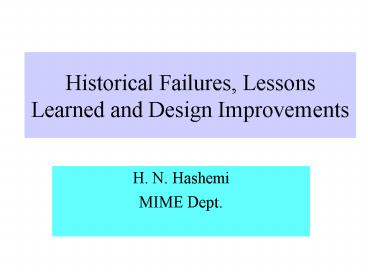Historical Failures, Lessons Learned and Design Improvements - PowerPoint PPT Presentation
1 / 41
Title:
Historical Failures, Lessons Learned and Design Improvements
Description:
Kansas City Hyatt Regency hotel opened in 1980. 40-story tower. Function block. Connecting atrium with three elevated walkways 117 ft (36 m) long. Initial Design ... – PowerPoint PPT presentation
Number of Views:164
Avg rating:3.0/5.0
Title: Historical Failures, Lessons Learned and Design Improvements
1
Historical Failures, Lessons Learned and Design
Improvements
- H. N. Hashemi
- MIME Dept.
2
Turbo-Generator Shafts Failure
3
Shaft is subjected to transient Torques
4
Mode of Failure
5
Life Estimation
6
Failure Modes
7
ISUZU Failure of the Break
8
Inspection of the System
9
(No Transcript)
10
(No Transcript)
11
(No Transcript)
12
Mechanism of Failure
13
Metallography Study
14
Merrimack River Dam Failure
- Mechanism of Failure, Strain Hardening of Rods
15
Hyatt Hotel Failure in Kansas City
16
(No Transcript)
17
Design and Factual Information
- Hyatt Walkway Collapse
- Kansas City Hyatt Regency hotel opened in 1980
- 40-story tower
- Function block
- Connecting atrium with three elevated walkways
117 ft (36 m) long
18
Initial Design
19
Designed was changed to this
20
The Change in Design Doubled the stress in the
joint
21
Since both the 4th and 2nd floor walkways fell,
which parts of the walkways could have failed?
22
(No Transcript)
23
(No Transcript)
24
(No Transcript)
25
1940 suspension bridge in Washington state
26
Third-longest in the world in 1940 (5000 ft
2800 ft center span) Quite narrow (39 feet two
lanes) Bridge deck supported by vertical cables
hung from two long cables strung from one shore,
over two towers, to other shore
27
- To reduce costs, sides constructed of solid
8-foot tall I-beams rather than typical open
trusses
28
(No Transcript)
29
November 7, 1940 (four months after opening)
- Midnight storm weakens bridge deck and cable
stays - Mid-morning wind reaches 40-45 mph
- Bridge closed at 10 am and bridge begins
torsional wave motion
30
(No Transcript)
31
Why did this bridge oscillate so much? Why did
this bridge fail when other, longer bridges
didnt? What design changes might have prevented
this failure?
32
- Solid I-beam girders, unlike trusses, did not
allow wind to flow through Flexible bridge
oscillated vertically (transverse waves) due
to vertical forces from vortex shedding as wind
flowed around side girders
33
Why did this bridge fail when other, longer
bridges didnt?
- More Vertical Deflection
- More Torsional Deflection
34
(No Transcript)
35
(No Transcript)
36
Failure Due to Inspections
- Nondestructive Evaluation such as
- Ultrasonic
- Eddy Current
- Thermography
- Radiography
- Vibrations
- Etc.
37
I 95 Bridge section failure due to missing a
large crack during inspections of the bridge
38
Poor inspections, missing cracks, resulted in a
disaster
39
(No Transcript)
40
(No Transcript)
41
- Thank you































